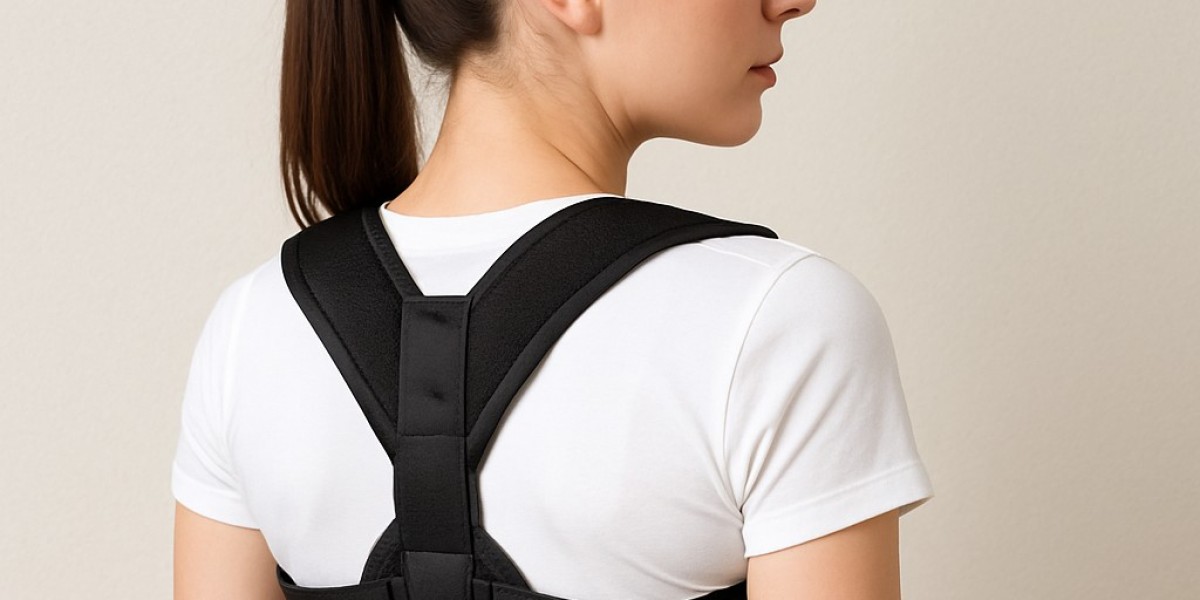Have you ever felt pain in your neck, back, or shoulders after sitting or standing for a long time? Many people face these problems daily without even knowing the real reason. In most cases, the problem is bad posture. When your body is not aligned properly, it puts extra pressure on your spine and muscles. Over time, this leads to pain, tiredness, and discomfort.
That’s where a posture corrector comes in. It’s a simple tool that helps you sit and stand in the right way. Whether you’re working at a desk, studying, watching TV, or using your phone, a posture corrector can keep your back straight and your shoulders relaxed.
In this article, we’ll learn everything about posture correctors. You’ll discover how they work, who should use them, and how to use them properly. If you want to improve your posture and feel better every day, this guide is for you.
What Does a Posture Corrector Do?
A posture corrector is a tool made to help you hold your body in the right position. It usually looks like a strap or belt that you wear around your shoulders and back. The main job of a posture corrector is to pull your shoulders back gently and keep your spine straight.
When you wear a posture corrector, your body gets used to sitting and standing in a proper way. It’s like a reminder for your muscles to stay in the right shape. Over time, your body remembers this position even when you’re not wearing the device.
Most posture correctors are made of soft, stretchy materials like nylon or cotton. They are comfortable to wear and can fit under your clothes. Some are very simple with just two straps, while others cover more of your back and even your lower waist.
The corrector helps reduce slouching, which is a common problem today. People who work long hours at desks or use mobile phones for too long often lean forward without realizing it. This can hurt your spine. A posture corrector gently pulls you back into shape, helping your muscles relax and reducing strain.
It’s important to remember that a posture corrector is not a cure for serious back problems. But it can be a great support for daily use. Think of it as a tool to train your body to stay straight, healthy, and strong.
Why Good Posture Really Matters
Good posture is not just about looking confident or standing tall. It’s about keeping your body healthy from the inside. When you have the right posture, your bones, joints, and muscles all work in harmony. This reduces stress on your body and helps you move freely and without pain.
Bad posture, on the other hand, can cause many problems. You may feel neck stiffness, shoulder pain, or lower back aches. Over time, poor posture can even lead to long-term issues like a curved spine or joint damage.
Let’s look at why good posture matters:
1. Less Pain and Discomfort
When your posture is right, your muscles and bones stay aligned. This takes the pressure off your neck, shoulders, and back.
2. Better Breathing
Standing or sitting straight allows your lungs to expand fully. This helps you breathe deeply and improves oxygen flow.
3. Improved Digestion
Believe it or not, posture also affects your stomach. When you slouch, it can squeeze your digestive organs and cause problems like gas or heartburn.
4. Boosted Confidence
People with good posture look more confident and self-assured. You appear taller, stronger, and more alert.
5. Better Focus
Good posture can increase energy and concentration. When you’re not in pain, you can focus better on work or study.
A posture corrector helps you achieve and maintain this good posture. It’s a simple way to protect your health and feel more comfortable in your daily life.
Who Can Benefit from Using It
Anyone who wants to improve their body alignment can use a posture corrector. It’s not just for people with back pain. In fact, the earlier you start using one, the better you can protect your body.
Here are the people who can benefit the most:
1. Office Workers
If you work at a desk all day, chances are you slouch without even noticing. A posture corrector helps you sit properly and avoid stiffness.
2. Students
Students often carry heavy bags and study for long hours. This can hurt their back and shoulders. A corrector helps them develop better posture habits early.
3. Elderly People
As we age, our muscles weaken, and we often bend forward. A corrector offers support to keep the spine straight.
4. Fitness Enthusiasts
Good posture helps with balance, breathing, and workout performance. A corrector can improve posture while doing exercises.
5. People With Past Injuries
Those recovering from back or shoulder injuries can use posture correctors as part of their healing process.
6. Remote Workers
Working from home often means less movement and poor chair setups. A posture corrector can help maintain proper sitting habits.
If you notice that you often hunch, lean forward, or feel discomfort in your back, it’s a sign you could benefit from using a posture corrector. It’s always a good idea to check with a doctor or physiotherapist if you’re unsure.
Choosing the Right Posture Corrector
Choosing the right posture corrector is very important. If it doesn’t fit well or feel comfortable, you may stop using it. With so many options in the market, it can be confusing to pick one. Here’s how to choose the best one for your needs:
1. Decide the Type
There are many types — upper back braces, full back supports, and lower back belts. Choose based on where you feel the most strain.
2. Check for Comfort
Look for soft, breathable materials. The straps should not dig into your skin or feel too tight. You should be able to wear it for at least 30 minutes without discomfort.
3. Size and Adjustability
Pick the right size for your body. Many correctors come in adjustable styles, which is helpful if you are in between sizes or want a tighter or looser fit.
4. Ease of Use
You should be able to put it on and take it off easily without help. This is especially important for daily wear.
5. Under or Over Clothes
Some people prefer to wear posture correctors under their shirts, while others wear them over clothes. Choose one that suits your preference.
6. Read Reviews
Before buying, check user reviews online. Real customer experiences can tell you how well a product works in everyday use.
By choosing the right posture corrector, you’ll enjoy better results and a more comfortable experience. Don’t rush your decision. Take your time to find what suits your lifestyle.







